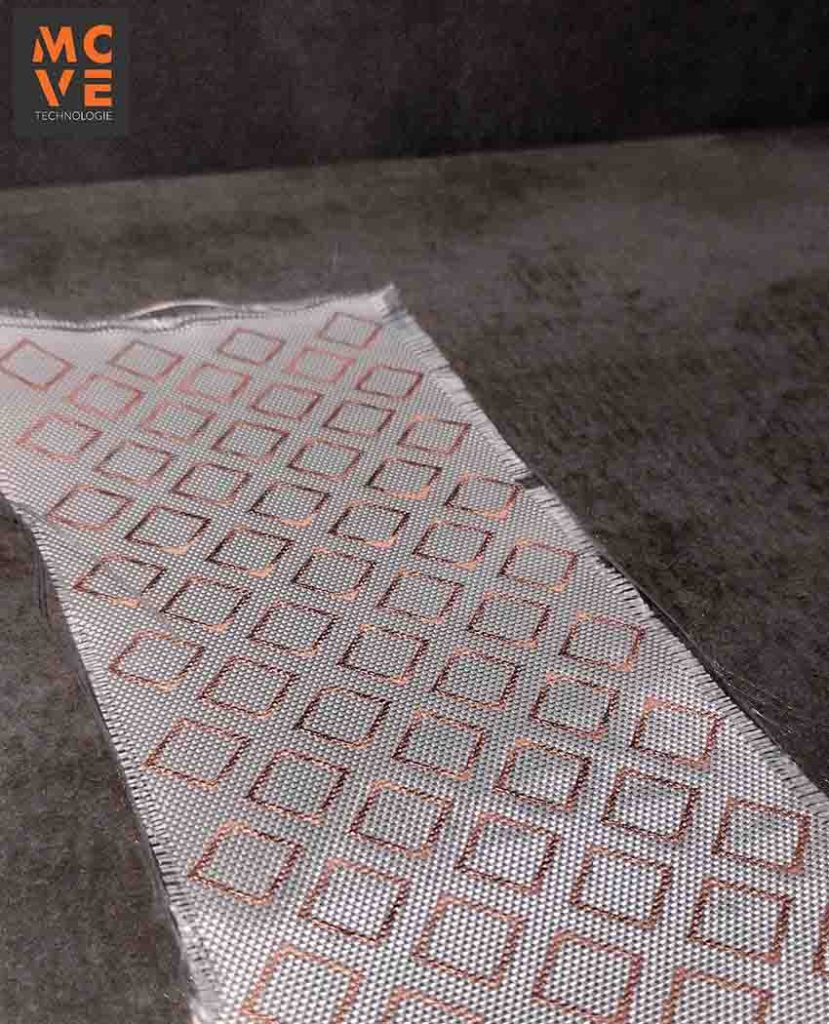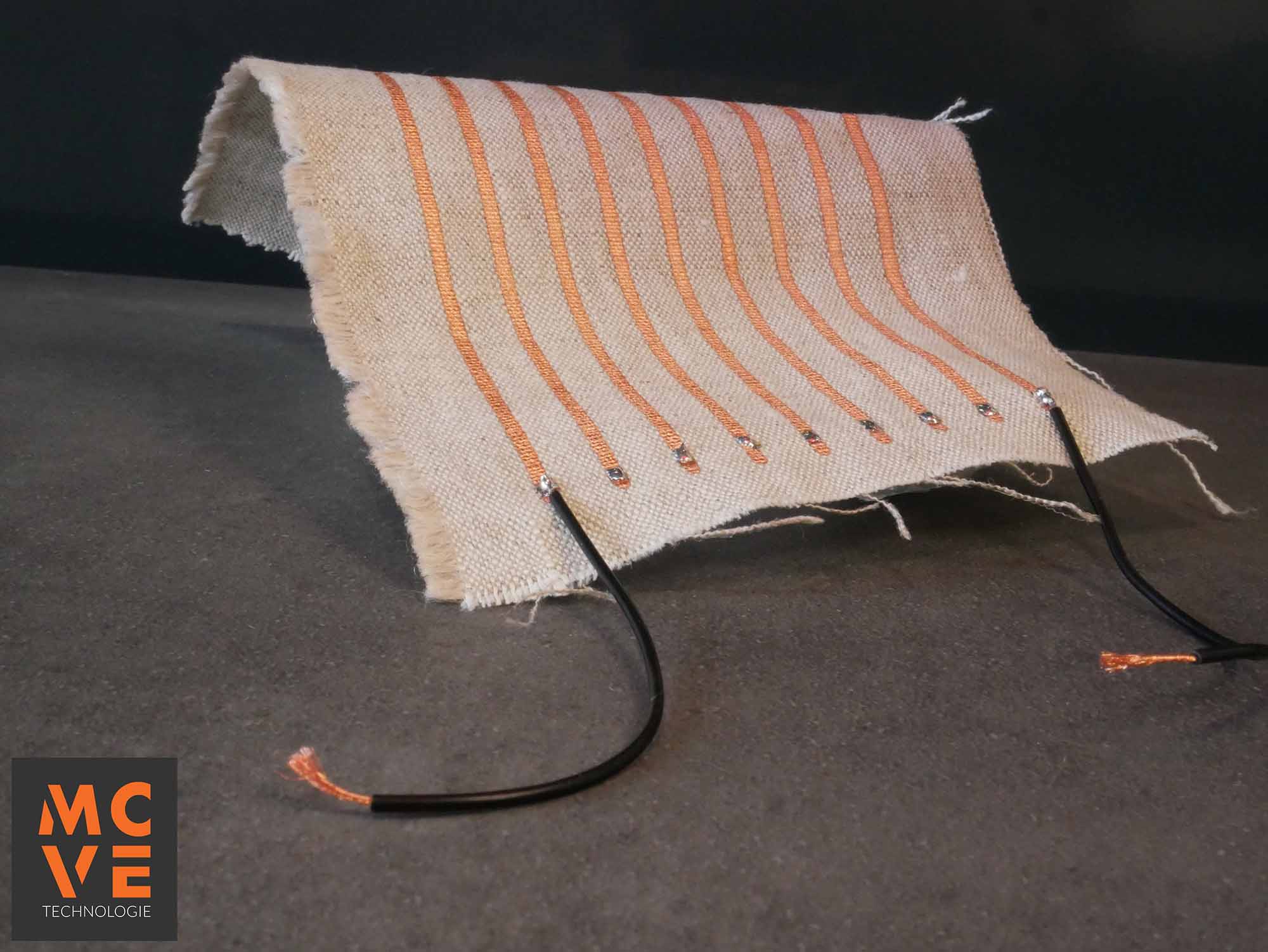MCVE is an innovative new company specializing in the application onto fabric of its proprietary patented Copper formulation, EOPROM®, resulting in the creation of copper metal circuitry. Their manufacturing capabilities extend to sizes of up to 300x380mm, and MCVE is actively investing in the utilization of established industrial processes such as printed electronics and Roll to Roll (R2R) to produce functionalized fabric rolls.
Currently, the company’s product portfolio includes the production of antennas and heating circuits on a variety of fabrics, including glass fiber, flax, basalt, PET, and organosheet.
Interview with Christian Weisse, CEO of MCVE.
Easy Engineering: What are the main areas of activity of the company?
Christian Weisse: MCVE is manufacture coupons glass fiber fabrics with electronic function to be integrated into composite materials without damaging composite integrity.
We can deposit Copper on fabrics to manufacture antenna, cabling, heating and RLC function and also PZE sensors or actuators by using our deposition technology.
E.E: What’s the news about new products?
C.W: One of the key strengths of our technology is its non-disruptive nature. Our functionalized fabrics seamlessly integrate into composite multilayers without causing any damage throughout the composite’s lifecycle. This successful integration has been validated and documented in the prestigious JEC Magazine.
Moving forward, MCVE is dedicated to expanding its product offerings by integrating sensors into our fabrics, creating a sensor network known as the “smart skin” for Structural Health Management (SHM) purposes. These sensors are constructed using patterned PZE sensors through the use of PZE formulation and EOPROM® electrodes.

Our ultimate goal is to install this “smart skin” on every composite structure with moving components. This “smart skin” will have the capacity to analyze, detect, and transmit data, resulting in decreased maintenance costs and the establishment of prognostic evaluations for the composite material’s lifecycle (PHM). By leveraging established industrial processes, MCVE aims to make these “smart skin” solutions readily available in large volumes for the composite industry, thereby significantly enhancing the composite material’s lifecycle. The introduction of MCVE’s smart skin will play a key role in the advancement of structural monitoring.
E.E: What are the ranges of products?
C.W: Notably, our heating circuits exhibit impressive power density levels, providing:
- 2kW/m2 at 400V
- 6kW/m2 at 950V.
These heating circuits have been specifically designed for anti-icing and de-icing applications in wind turbine blades.
Concerning the antenna, we can manufacture FSS (frequency surface specific) and also EBG (Electromagnetic BandGap) which is a structure that creates a stopband to block electromagnetic waves of certain frequency bands by forming a fine, periodic pattern of small metal patches on dielectric substrates. We can build in this way multilayers antenna integrated directly on the composite.
E.E: What is the state of the market where you are currently active?
C.W: MCVE Technologie is poised to invest in an advanced industrial automated manufacturing process to enable the mass production of functionalized fabrics. These fabrics will be used to create antennas, circuits, heaters and sensors essential for the growing composite materials industry. The company’s innovative Roll to Roll (R2R) manufacturing process will serve as a locally-sourced, environmentally friendly additive technology solution for the European industry.

At the heart of MCVE’s process lies its proprietary and patented technology, EOPROM®. The company has chosen to qualify an additive process for producing printed electronics on glass fiber fabrics, known as EopromFlex® (R2R). The target market includes applications that combine smart fabrics with composite materials and electronics. MCVE adds value to composites by integrating electronic functionalities into these materials, and the EopromFlex® process enables the supply of new flexible circuits to the European market using a unique additive method.
The challenge in composites is to meet increasingly complex specifications and integrate multiple functions into a single material. MCVE’s overall strategy is to become a master of composite functionalization technology and ultimately to license this innovative approach. The applications are diverse, starting with the continuous Structural Health Monitoring (SHM) where the screen-printing process allows the addition of features such as antennas, wiring, heating, sensors and actuators.
The incorporation of these functions will allow MCVE to market and license their integration into composite materials. Collaborations with various laboratories have validated their innovation, enhancing the company’s expertise. MCVE is poised to be at the forefront of structural health management by manufacturing a sensor network for monitoring the integrity of composite materials. Ultimately, the company aims to provide a digital solution that offers valuable digital data for each composite structure, from initial qualification tests and certification through its lifecycle and re-certification if needed. This digital solution can also find applications in various other composite scenarios.
Introducing new functionalities to composite parts involves mastering various processes. Printed electronics, particularly EOPROM® – based conductive ink with metallic copper particles, offer numerous advantages, including flexibility, lightness, compatibility with diverse substrates, and cost-effectiveness. Roll to Roll screen-printing is an ideal method for consistently and efficiently implementing electronic functions on glass fiber fabrics for integration into composite structures. MCVE’s long-term vision includes printing an array of PZE sensors directly onto composite fabrics, enabling continuous monitoring of composite structures’ health through its onboard PZE sensor technology.
By combining expertise in designing, developing formulations, and implementing printed electronics for PZE sensors with composite design, processing, and manufacturing capabilities, MCVE is paving the way for continuous structural control in composites. The company’s use of low-cost PZE sensors without altering the manufacturing process opens up new possibilities for composites across various domains. This approach not only reduces the number of components and simplifies assembly but also provides an affordable means of incorporating structural health monitoring into composites.

E.E: What can you tell us about market trends?
C.W: The growing market for smart composites requires efficient data management systems. MCVE’s printed additive technology on glass fiber fabrics allows for the digitalization of composite structures. This innovation isn’t limited to GFRP; it extends to CFRP structures as well. Moreover, MCVE’s technology facilitates the simultaneous printing of PZE sensor networks and antennas, enabling wireless data transmission. This dual capability improves the functionality and connectivity of composite materials, meeting the changing requirements for data generation and transmission within composite structures.
E.E: What are the most innovative products marketed?
C.W: The integration of printed structures using Eoprom® or PZE paste has no adverse impact on the mechanical performance of FRP (Fiber-Reinforced Polymer) materials. MCVE’s expertise has confirmed the excellent chemical compatibility of the functionalization with the overall matrix of the FRP. This successful integration of printed structures opens up a wide range of possibilities for the design and integration of various functions within composite materials. There is plenty of scope for innovation and customization. The concept of functional integration through printing on fabrics can be extended to various applications, including but not limited to de-icing solutions for wind turbine blades, antenna design, Structural Health Monitoring (SHM) applications, and a myriad of other limitless possibilities. This approach not only maintains the material’s mechanical integrity but also enhances its functionality, making it a versatile solution for a wide range of industries and use cases.
E.E: What estimations do you have for the rest of 2023?
C.W: We recently have validated different application for industrial purpose in sport and also for de-icing which will pave the way to large, big orders needed to launch our pilot line to deliver functionalized glass fiber rolls to serve the composite industry.


